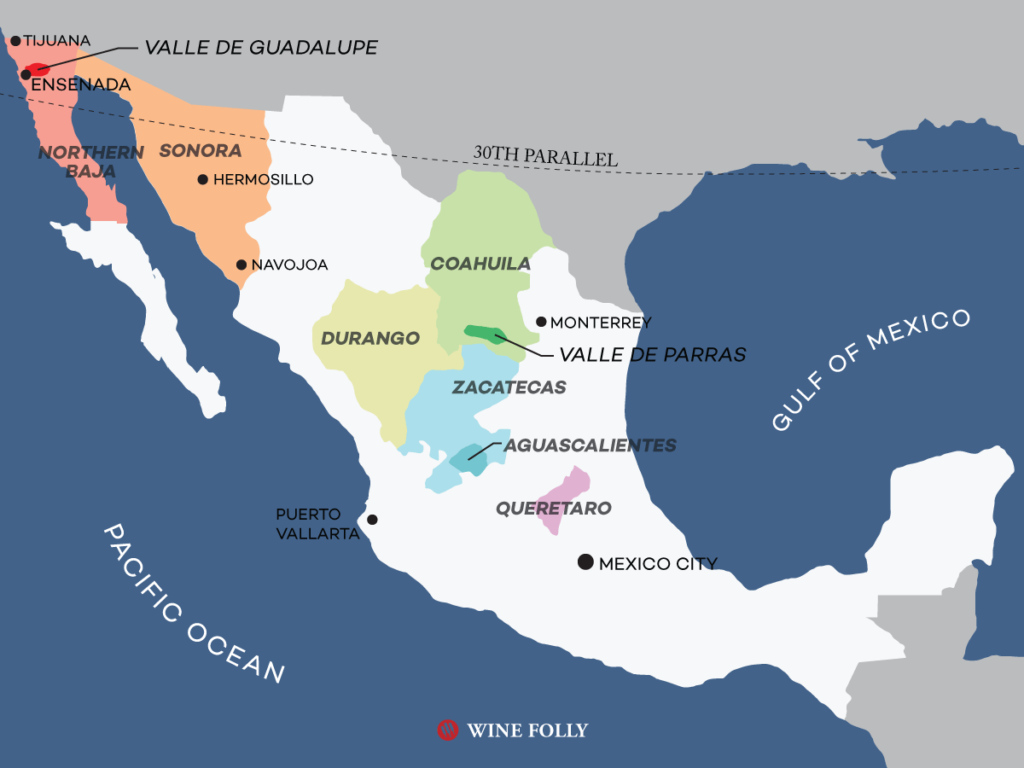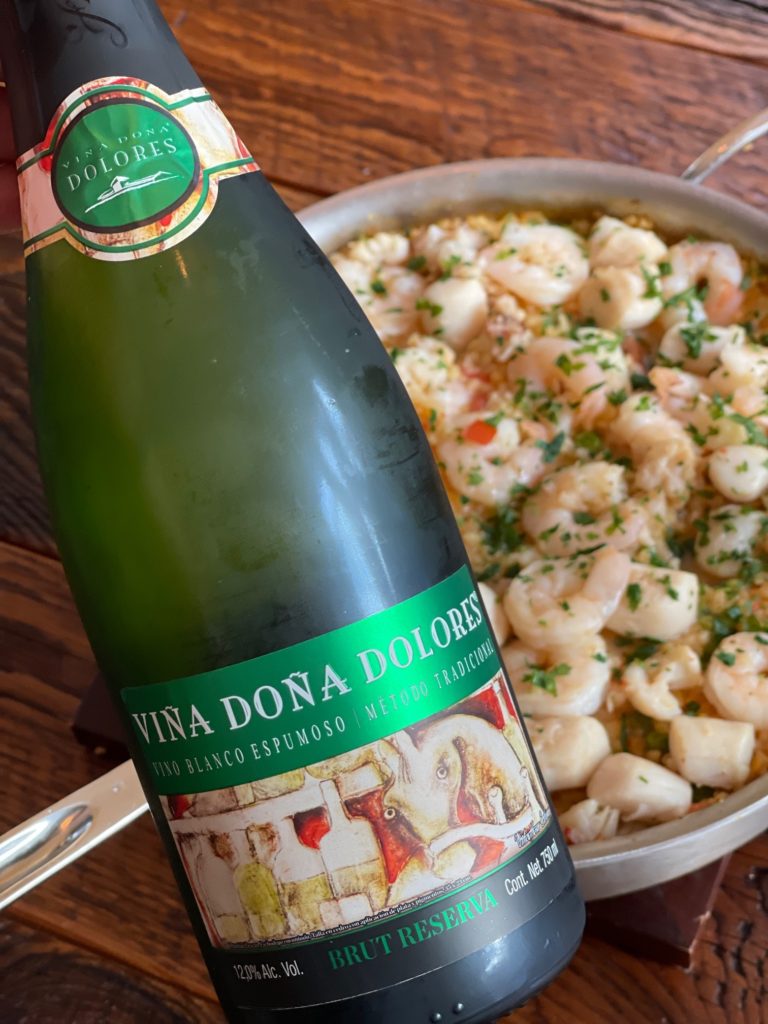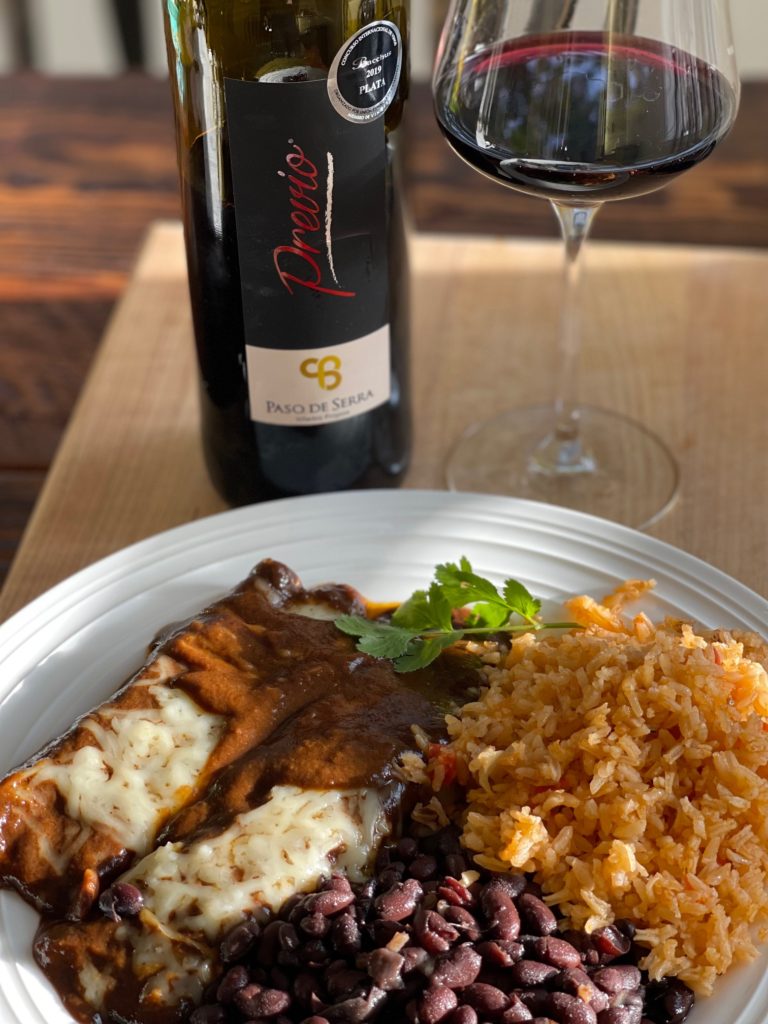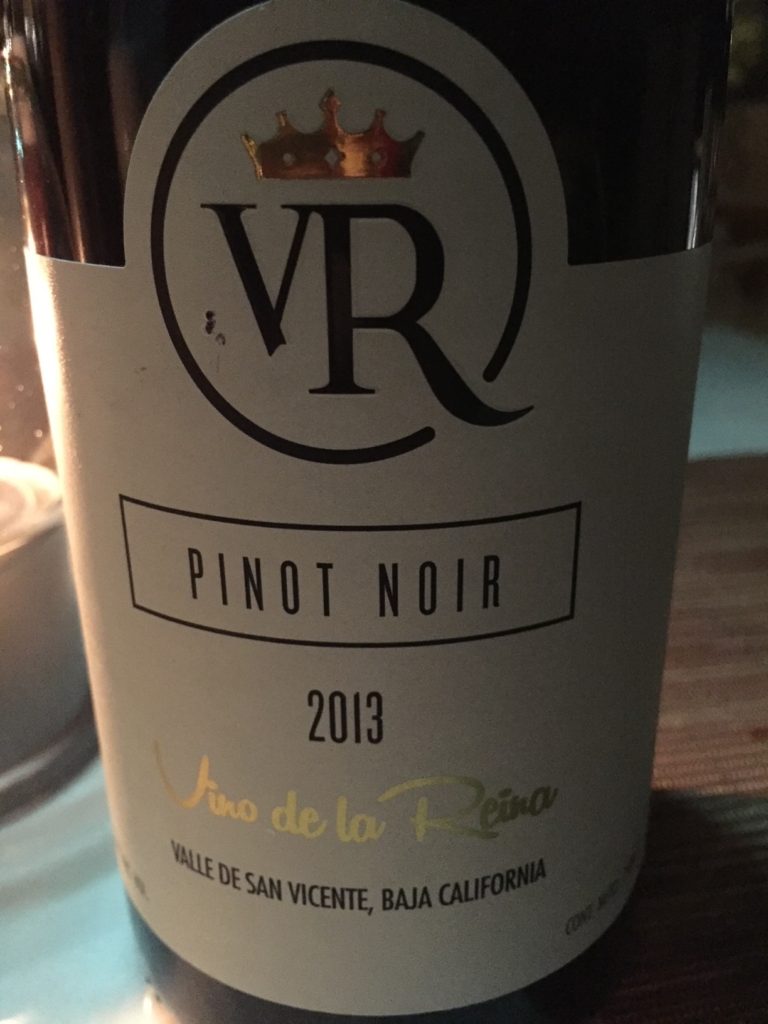This month the Wine Pairing Weekend group is tasting Mexican wine and offering food pairing to boot!
My first introduction to Mexican wine was in 2017, while on vacation in Nuevo Vallarta in Baja. While there, we tried the Pinot Noir pictured below and a Syrah, also from Baja.
The wine was recommended by the sommelier at the upscale restaurant in the resort where we stayed.
Both wines were quite good and, at the time, I remember being pleasantly surprised. I knew wines were being made in Mexico, but both were better than I expected given Mexico’s hot and arid climate(it should be noted the prevailing theory is that the 30th Parallel boundary[see map below]for successful wine grape growing).
Mexican Wine At A Glance
The first vineyards in North America were planted in Mexico in the 16th century by the Spanish. And as with Old World countries such as France and Spain it was men of the cloth who were responsible for establishing viticulture in Mexico. In this case it was Fr. Junipero Serra.
But it wasn’t until the 1970s, when foreign investors looking for new opportunities, that the Mexican wine industry started to see growth.

Mexican wine at a glance:
Area under vine: ~8,000 acres
Primary Wine Growing Regions: The 3 primary wine regions are 1) The North in the Baja Peninsula, 2) La Laguna which straddles the states of Durango (mostly grapes for Brandy) and Coahuila which include the prime growing area of Valle de Parras which is sit at about 5,000′ elevation, and 3) Central Mexico, which includes Zacatecas, Aguascalientes, Guanajuato (it’s southeast of Aguascalientes as the crow flies) and Querétaro, which sit at elevations of up to 6,500′.
Climate: Overall Mexico has a tropical climate, but the primary grape growing areas benefit from either proximity to the Pacific Ocean (Baja Peninsula) which offers moderating cooling, or high altitude areas (La Laguna and Central Mexico) offers with warm days, cool nights that create desirable diurnal shifts, and low humidity.
Red grapes: Predominately Cabernet Sauvignon, Merlot, Malbec, Tempranillo and Syrah. Other include Carignan, Nebbiolo and Zinfandel
White Grapes: Chardonnay, Sauvignon Blanc, Chenin Blanc, Riesling, and Semillon
Soils: Baja has granite-rich alluvial soils, while La Laguna and Central Mexico are dominated by loamy-clay soils
Annual production: It is estimate that 75-85% of Mexican wine is produced in Baja.
Despite it’s Spanish heritage, Mexico’s is not a major wine-drinking country. Beer, Brandy and Tequila are far more popular. The fact that the Mexican government imposes taxes of 40% per bottle certainly doesn’t help the wine industry. Despite that, wine consumption in Mexico is growing, particularly in major cities and tourist areas.
Nevertheless wine consumption is growing in Mexico, though most of the wine is imported from imported from Europe, Chile, Australia and New Zealand. About 40% of the wine consumed is domestic.
Disclosure: These wines were provided as media samples. No other compensation was involved. All opinions are mine.
Wines Tasted And Pairings
Both of the wine samples I received were from the Querétaro wine growing region, so it provided me a chance to explore Mexican wines beyond Baja.
Freixenet de México Viña Doña Dolores Brut Reserva
This wine is a 50/50 blend of Macabeu and Xarel-lo, the same grape varieties used to produce Spanish Cava. The Querétaro wine region is known for its sparkling wine thanks to Finca Sala Vivé by Freixenet México, a subsidiary of the Spanish Freixenet enterprise that chose this region for its microclimates back in the 1970s.
It’s produced using the Traditional Method, and aged 18-24 months sur-lie.

Tasting Note:
Pale straw color with toasted brioche, green, Asian pear and pink grapefruit aromas. On the palate it’s medium-bodied and fresh with a soft mousse with enticing green apple, ripe pear, mandarin orange and pink grapefruit flavors. 12.5% abv|SRP – $15
We paired this wine with homemade Seafood Paella. My wife and I both adore Paella and we both make it. We’ve tried it with many wines (mostly rosé), but I don’t recall pairing it with a sparkling wine. I didn’t realize what I was missing. What a treat!
2016 Paso de Serra ‘Previo’
This wine is a blend of of 70% Malbec, 20% Merlot, 10% Syrah from the wine producing state of Querétaro. The wine is named for Junipero Serra of the Franciscan Order, who planted the first vines in the region. He is credited with building the five main missions of the area and completing the evangelization of the local people before continuing on California

Tasting Note:
Opaque violet color with plum, dark cherry liqueur, cacao, tobacco, and peppercorn aromas. On the palate, it’s medium-bodied with medium-acidity and firm, mouth drying tannins. It shows plum, black cherry, blackberry, nuanced pomegranate, and savory spice flavors. 13.8% abv
We paired this wine with take-out of Plato de Mole with Mole de Queso, Black beans and rice. It was a wonderful complementary pairing as the spice notes in the wine were a match for the savory, spicy notes in the food. Additionally, the wine’s alcohol level was moderate enough to not incite the moderate spiciness of the food.
Here is what my fellow Wine Pairing Weekend bloggers discovered about Mexican wine and food pairings:
- Wendy from a A Day in the Life on the Farm will share “Mexican Foods and Wines always provide for a Perfect Fiesta”
- Susannah from Avvinare is “Discovering Mexican Wine”
- Jen from Vino Travels is taking “A First Look at Mexican Wines Including Italian Grapes”
- Carlos from Carlos’ Food & Wine is serving up “Mexican wines featuring sparkling wine risotto & grilled hanger steak with mushroom-red wine sauce”
- Camilla from Culinary Adventures with Camilla is sharing “Outside the Pigeon-Hole: Pairing Mexican Wine with Thai Cuisine“
- Gwendolyn from Wine Predator Gwendolyn Alley features Sparkling Wine from Mexico For #TacoTuesday”
- Robin of Crushed Grape Chronicles shares “Mexican Wines – 2 wines from the central Mexican highlands of Querétaro #WinePW“
- Linda from My Full Wine Glass is “Saying ‘hola’ to Mexican Tempranillo and sparkling wine”
- Martin from ENOFLZ Wine Blog will share “Exploring Mexican Wine Beyond Baja”
- Nicole from Somm’s Table is “Sipping Mexican Wines with a Bowl of Birria“
- Liz at What’s in that Bottle posted “Salud a Los Vinos de Mexico!”
- Terri from Our Good Life pairs “Grassfed Ribeye with Steak Butter and Grilled Oyster Mushrooms Paired with Monte Xanic Cabernet Sauvignon“
- Here on Cooking Chat we paired “Roasted Beet Pesto Pasta with Mexican Merlot”
If you’re up early enough, please join our Twitter chat at 8am PT, on Saturday, April 9th. Just follow the #WinePW hashtag so we can see you.

We tasted the single varietal Syrah from Paso de Serra and I was wondering about the blend, so I was anxious to read your tasting notes. How amazing that some of the original Father Junipero Serra vines are planted here.
I enjoyed your post about the Paso de Serra Syrah. I couldn’t help think about Fr. Serra and how he has become a controversial figure in CA.
Lots of good info about Mexican wine in your opening! Both pairings look great — been too long since I’ve had mole. Need to try it with one of these wines!
Thanks David. I’ve never made mole. I’ve always found the recipes to be a bit intimidating. One of these days, I’ll get over that and give it a try!
That Paella made me swoon. It look so good.
Thanks Wendy. Paella is a favorite around here!
I didn’t realize the tax on wine in Mexico was so high. That would be a difficult hurdle to surmount. Both of these pairings sound amazing. I do love mole and now this has started the craving up again.
Thanks Nicole. When I heard how high the tax is on Mexican wine, I couldn’t believe it either. Hopefully that will change with time.
Mole is one of my favorite foods and sounds delicious with this Malbec blend. I’m craving this pairing now!
Thanks Linda! I hope you had a chance to get that mole craving satisfied. Have you ever made it? I’ve always purchased because the recipes looks so intimidating to me.
We had our first Mexican wine this past January when on holiday — the Casa Madera 3 V and it was terrific! Really opened our eyes to the region and now we have some further research to do. And please let me know when you’re next making paella, we’ll be right down 😉
I love the “research” intensive focus you two have;-)
Martin –
Great information on the region and tasting notes. Also, that Seafood Paella looks divine and I am inclined to buy another bottle of that sparkler and try it with paella. Do share your recipes. Cheers to you, Susannah
Thanks Susannah. Paella is a favorite in our home. Seafood Paella with this sparkling wine was a no-brainer for me (though it was the first time I’ve had Paella with bubbles!)
That mole looks delicious! We enjoyed the espumoso also!